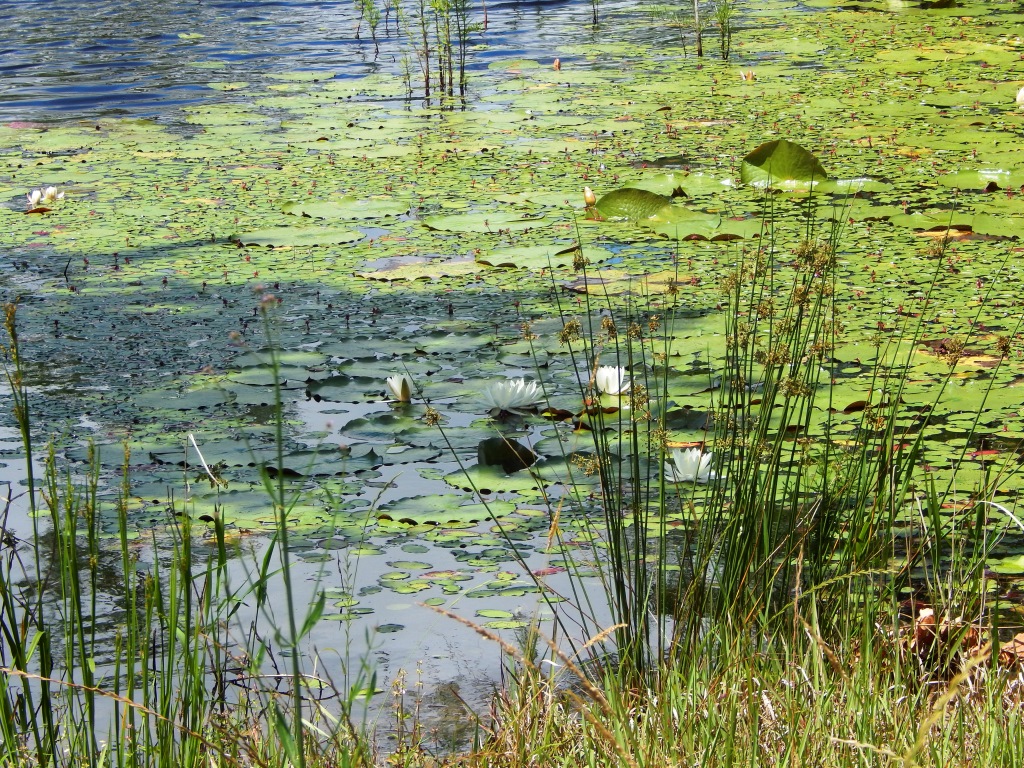
by Mark Mauldin | May 22, 2016
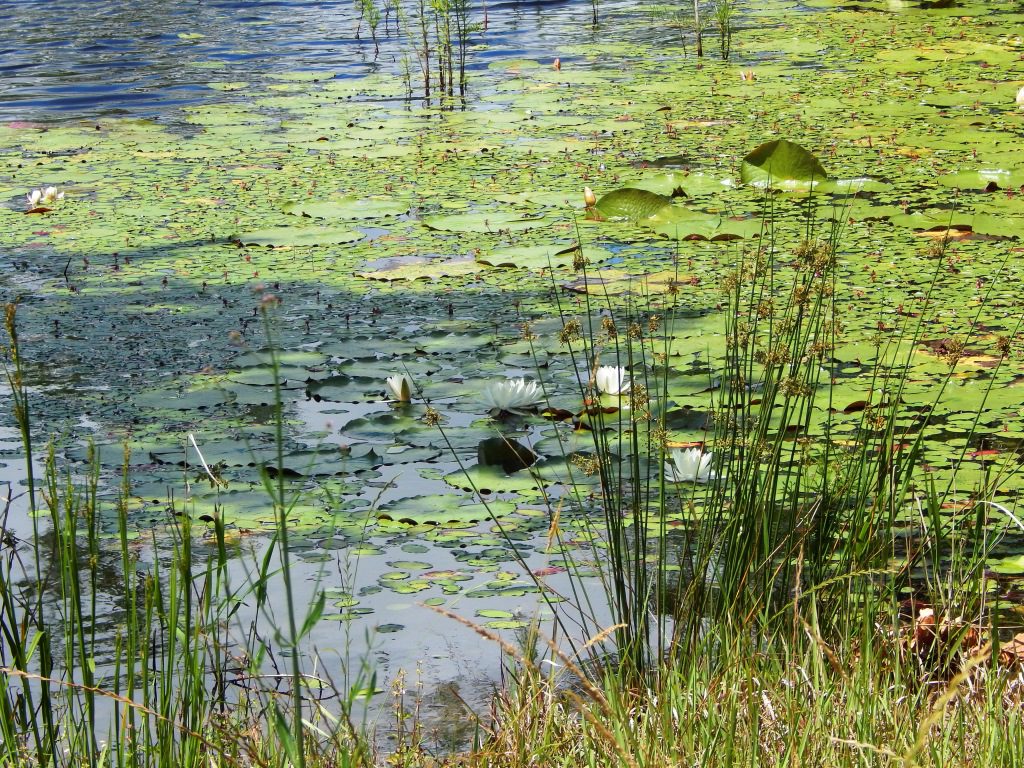
Managing a pond can be both rewarding and challenging.
Photo Credit: Mark Mauldin
Ponds can be a source of great enjoyment. However, properly managing them to meet your desired goals can be challenging. Panhandle Pond Management, a two part series being offered by UF/IFAS Extension, is designed to help pond owners/managers become more successful in reaching their goals. Specialists from campus will be onsite to share their expertise. Dr. Chuck Cichra, UF Fisheries and Aquatic Sciences, will lead session 1 and Dr. Stephen Enloe, UF Center for Aquatic and Invasive Plants, will lead session 2.
Session 1 – May 31st Fish Management will focus on decisions that the pond owner can make that directly relate to the success and productivity of the fish population in a pond. Stocking, harvesting, feeding, aeration and other topics will be covered.
Session 2 – June 7th Aquatic Weed Management will involve weed identification, control options, and herbicide application techniques. If you have problem weeds bring samples for identification and control recommendations.
Panhandle Pond Management will be held at the Washington County Agricultural Center, 1424 Jackson Ave, Chipley FL. Each session will begin at 6:00pm; a meal will be served. To ensure we have enough food advanced registration is strongly encouraged. There is a $10 registration fee per session. To register call the Washington County Extension Office (850-638-6180) or use the links below for online registration. Session 2 attendees will receive a copy of Weed Control in Ponds a bound book sold through the IFAS bookstore.
Online Registration
Session 1 – https://goo.gl/Rwn9dk
Session 2 – https://goo.gl/zj58o6
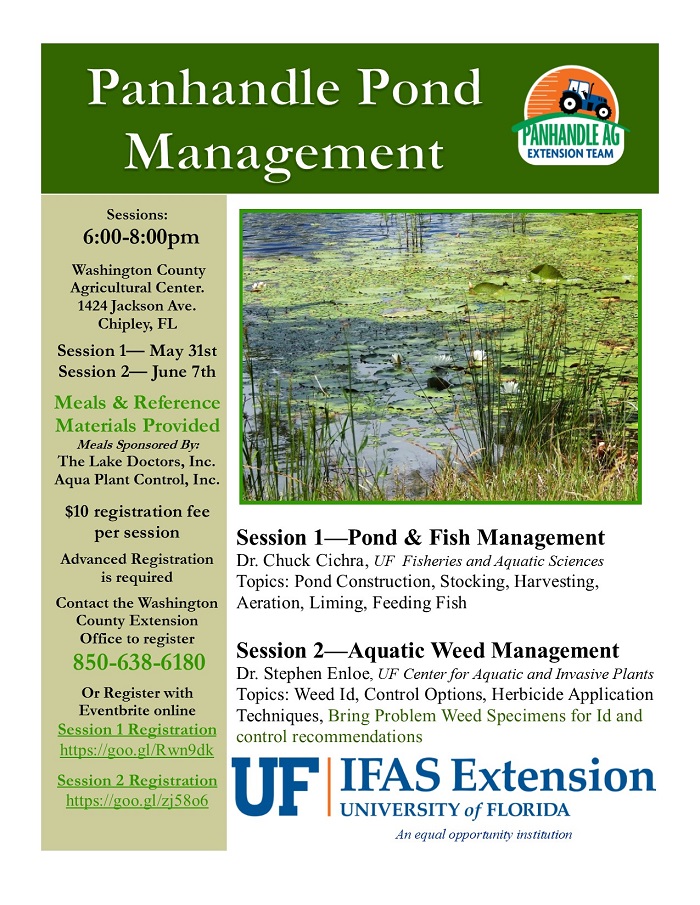
by Mark Mauldin | Oct 1, 2015
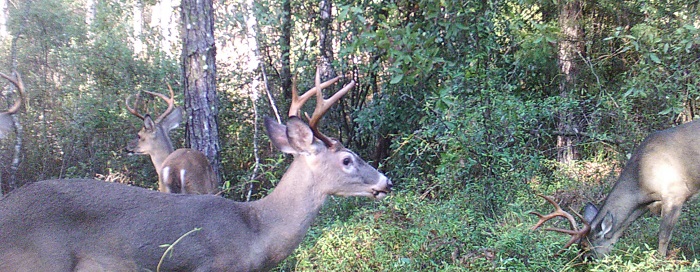
As summer browse dwindles the habitat improvement associate with wildlife food plots becomes even more evident.
Photo Credit: Mark Mauldin
Improving habitat can benefit the quantity and quality of wildlife on a piece of property. One common method for improving habitat is the establishment of food plots. Food plots are simply areas that are managed for the production of forages that help meet the nutritional requirements of the desired wildlife species.
The implementation of food plots has gained popularity largely through its association with hunting, specifically white-tailed deer hunting. Food plot establishment and hunting success can be directly related; attracting game to a specific area via the establishment of a highly desirable plant species. That said, rarely are food plots which are planned and utilized only as attractants very successful. Truly successful food plots are developed with yearlong habitat improvement in mind; improved hunting on the property is a by-product of the improvement in habitat.
Successful implementation of wildlife food plots takes planning and consideration. Many factors must be considered;
- Site selection: Factors like size, shape, soil characteristics, and location can greatly affect the potential success of a food plot.
- Nutritional demands of wildlife: Throughout the course of the year the nutritional demands of wildlife change. Wildlife, especially deer, will show preferences for different plants at different times of the year based largely on the nutritive value of the plant. Successful food plots seasonally match the nutrition offered to the nutrition need by the wildlife.
- Plant selection: Selecting the best species and varieties to plant in a food plot is a decision that tends to get a lot of attention, and rightfully so. Plantings should be selected based on how well they are adapted to the site, propensity of wildlife to utilize them, and how well they fit into the yearlong rotation. It is always advisable to plant a blend of multiple species, planting windows and persistence of the plants must be considered when formulating these blends.
- Agronomic practices: If all other factors are considered and appropriately addressed the success of a food plot is still dependent on the ability of the land manager to effectively plant and manage the crop(s). Soil fertility, weed control, planting depth, seeding rate, etc. all need to be correctly addressed to have a successful food plot.
Planning and hard work are prerequisites for successful food plots but when everything comes together seeing the benefits they provide can be a truly rewarding experience. If you are interested in learning more about successfully improving wildlife habitat through the implementation of food plots please consider attending Wildlife Food Plot Fundamentals. This workshop will be at the Washington County Agricultural Center on Thursday October 8th beginning at 6:30pm. Please see the flyer for more details, for questions or to register contact Mark Mauldin with UF/IFAS Extension, Washington County (850-638-6180, mdm83@ufl.edu).
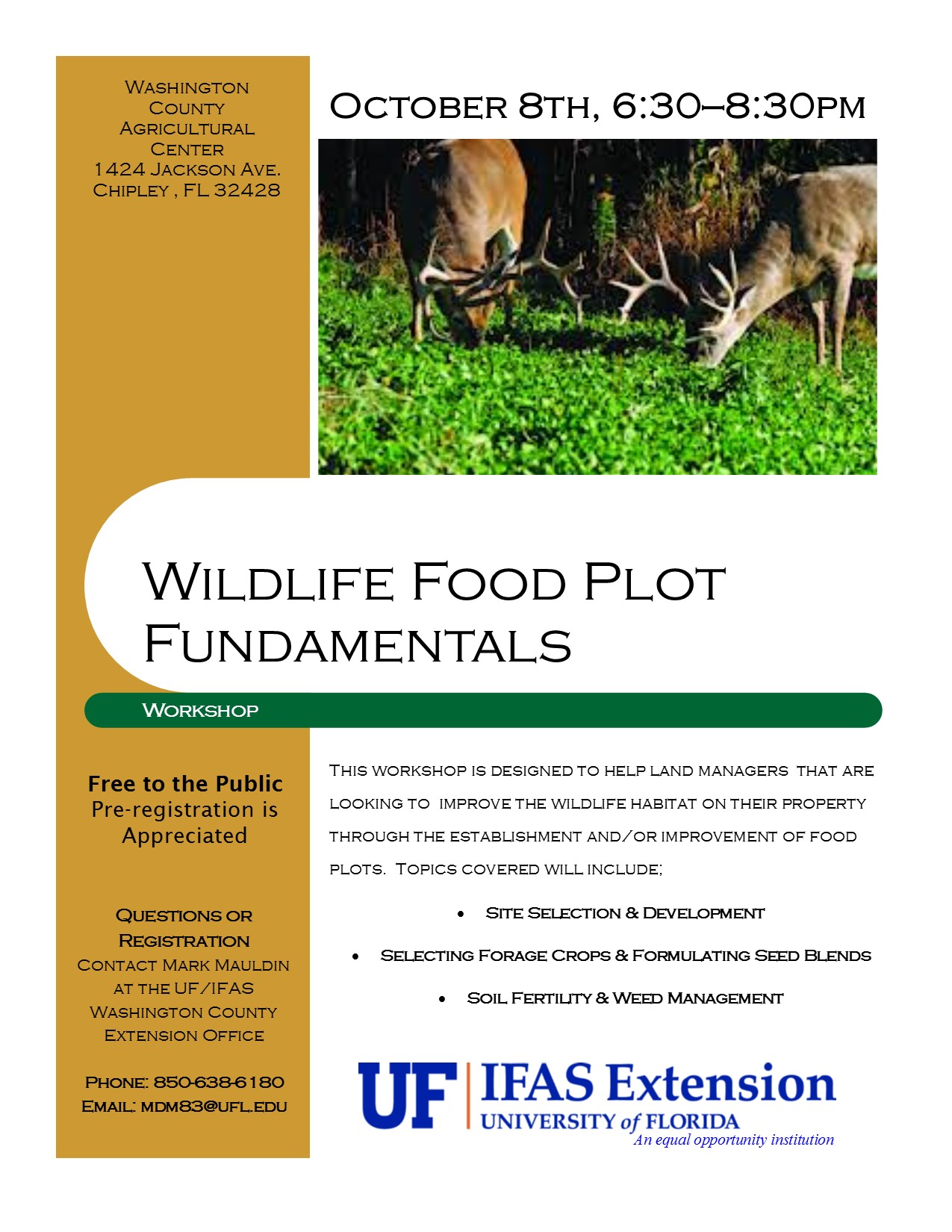
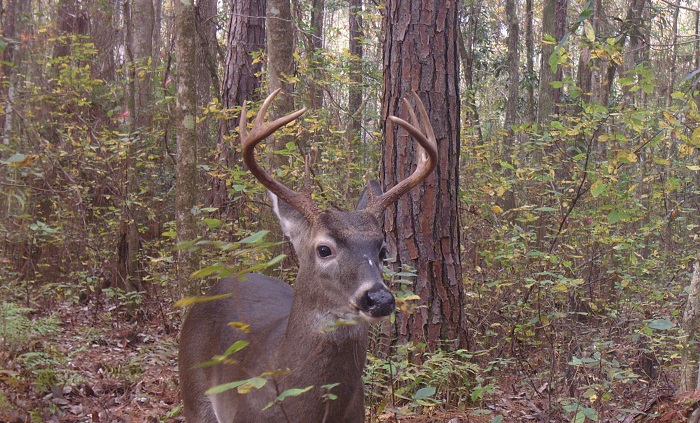
by Mark Mauldin | Aug 21, 2015

Deer hunting season is just around the corner. It’s time to start scouting and making preparations to plant cool season food plots. Photo Credit: Mark Mauldin
The temperature might still be in the 90s but the kids are back in school and football season is starting soon; that means fall is coming and with it, the beginning of hunting season. Here in northwest Florida archery season for deer and turkey begins October 24. While it might still be a little early to dust off your camouflage there are still plenty of things you can be doing this time of year to get ready for the start of hunting season.
If plan to utilize food plots on your hunting property this fall it is time to take soil samples and if need be, apply lime. All plants have a soil pH range where they grow best. For many of the plants we commonly use in food plots the ideal range for soil pH is above that of our soils here in Florida. Applying lime to the soil will increase the soil pH, but it takes time; months not weeks. There are a variety of liming products available but the most economical option is generally bulk, agricultural or dolomitic lime. Ideally lime would be incorporated into the soil well before planting. A soil test will provide specific recommendations about how much lime and fertilizer your site needs. Your county extension agent can assist you in submitting a soil sample for analysis and interpreting the results and recommendations. Soil pH greatly effects soil nutrient availability; spending money on fertilizer without checking or correcting the pH is not advisable.
It is still early to plant cool season food plots; planting should begin around October 1. It is not too early to begin researching what you want to plant and booking seed. If you are particular about what varieties you want to utilize (you should be) you should make arrangements with seed suppliers in advance. Always be sure to utilize crops and varieties that are well suited to your site. Be careful with premixes that are sold at chain stores. These products may not be well suited to our environment here in Florida. Contact your county agent and be on the lookout for future articles for more information on selecting the forage crops that are best suited to your area.
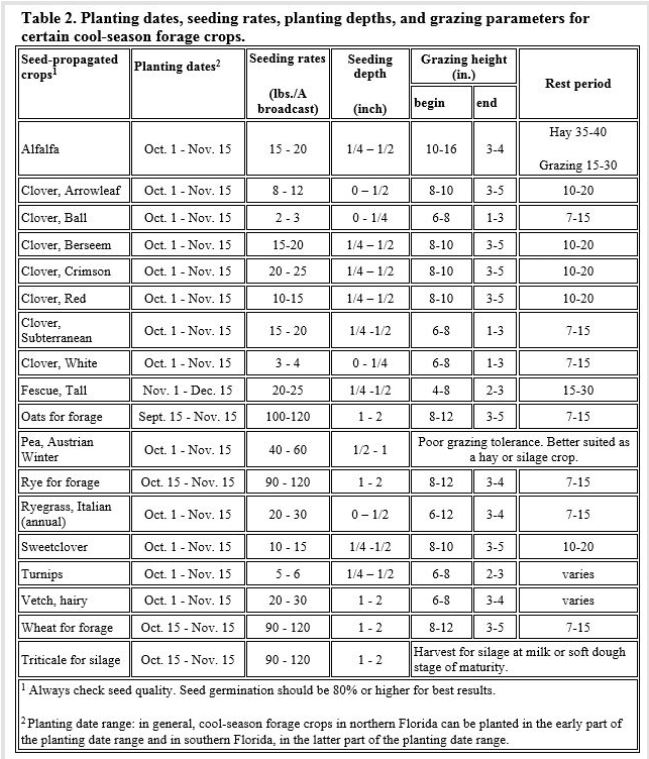
Chart from: 2015 Cool-Season Forage Variety Recommendations for Florida
By; Ann Blount, Patricio Munoz, Jose Dubeux, Joao Vendramini, Ali Barbar, Kevin Kenworthy, and Ken Quesenberry
If you are planning on hunting over feed (corn, etc.) you should have already began your feeding program. To legally hunt over feed the feeding station must have been maintained with feed continuously for at least six months prior to harvest game in the vicinity. In other words, if you start feeding corn today (8/20) you can’t legally hunt over it until February 20th. For more information regarding hunting over feed see the FWC webpage.
Using game cameras to monitor your property can help you get an idea about the quantity and quality of animals utilizing your property. Having this information before hunting season can help you plan management decisions in advance. Preseason scouting, on foot or with game cameras can also help you determine what parts of your property game are utilizing the most. Granted, there is still plenty of time for patterns to change before hunting season gets here. Another positive aspect of utilizing game cameras this time of year is that they give you an added excuse to spend a little extra time in the woods. In the months leading up to hunting season going to “check cameras” is somewhat of a Sunday afternoon tradition in my house.

Dense summer foliage and a bachelor group of NW Florida bucks can make for a fun game camera photo. How many bucks can you find? Photo Credit: Mark Mauldin
Long summer days give you plenty of time in the evenings to practice shooting your bow. Proficiency with a bow takes practice and repetition. I was once told, “Don’t practice until you can hit what you’re aiming at, practice until you can’t miss”. Practice now, don’t wait until you miss, or worse, wound an animal to realize you needed to improve your skills. In addition to working on your skills for hunting season, archery can be great outdoor fun for the entire family.
There are a lot of hot days to wait through still ahead of us but hunting season is coming; if you’re like me you’ll be happy to see it when it gets here. Now is the time to make plans and preparations so when the waiting is finally over you’ll be able to have your best season yet.
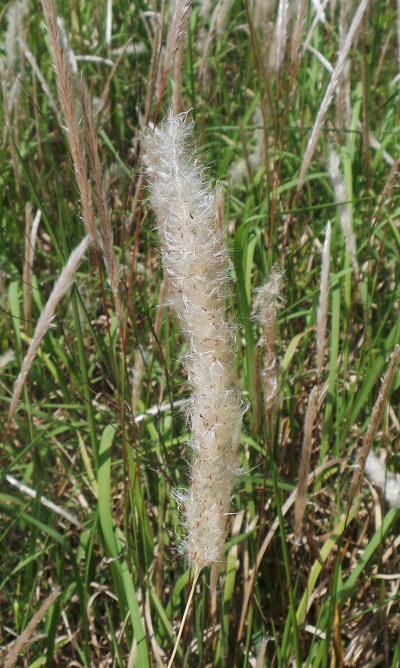
by Mark Mauldin | May 10, 2015
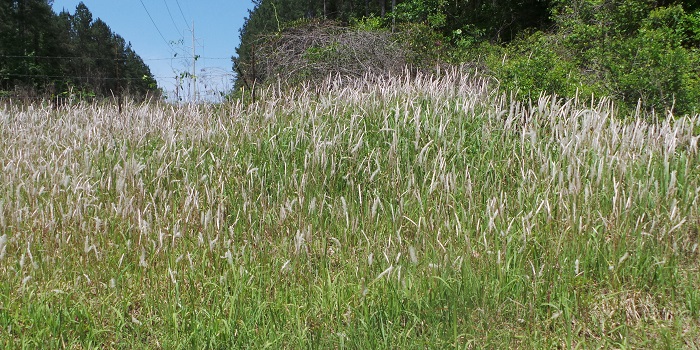
Cogongrass seedheads are easily spotted this time of year.
Photo Credit: Mark Mauldin
We are well into spring and a wide variety of plants are showing off their colorful blooms. As lovely as most of the blooms are, some springtime colors are an unwelcome sight. Such is the case with the showy, white seedhead that is produced by Cogongrass (Imperata cylindrica). The presence of Cogongrass – a highly aggressive, invasive, perennial – in Florida is not news; it has been in Florida since at least the 1930’s. However, the white seedhead that it produces in the spring makes it easier to locate and identify. When the seedhead is not present, the somewhat boring looking grass has the ability to blend in with its surroundings. This makes it harder for un-expecting landowners to identify the new/small infestations which are much easier to eliminate than are larger, well established infestations.

While cogongrass spreads primarily by rhizomes the seedheads can make new infestations easier to find.
Photo Credit: Mark Mauldin
Controlling cogongrass is not easy but it is necessary. If left uncontrolled cogongrass will continue to aggressively spread, displacing other desirable vegetation. Generally speaking, control is a multi-year process. Because the specific recommendations for controlling cogongrass can vary somewhat by situation it is highly advisable that you contact a UF/IFAS Extension Agent in your county if you suspect that you have cogongrass on your property.
The following description of cogongrass from UF/IFAS Center for Aquatic and Invasive Plants should help you identify cogongrass, even if the seedheads are gone.
“Cogongrass is a perennial that varies greatly in appearance. The leaves appear light green, with older leaves becoming orange-brown in color. In areas with killing frosts, the leaves will turn light brown during winter months and present a substantial fire hazard. Cogongrass grows in loose to compact bunches, each ‘bunch’ containing several leaves arising from a central area along a rhizome. The leaves originate directly from ground level and range from one to four feet in length. Each leaf is 1/2 to 3/4 of an inch wide with a prominent, off-center, white mid-rib. The leaf margins are finely serrated; contributing to the undesirable forage qualities of this grass. Seed production predominately occurs in the spring, with long, fluffy-white seedheads. Mowing, burning or fertilization can also induce sporadic seedhead formation. Seeds are extremely small and attached to a plume of long hairs.”
This is the time of year when cogongrass is the easiest to identify. Take advantage of this opportunity to locate new infestations and work with your county agent to develop a control plan. Once a plan is in place, follow it to the end. Stopping after the first year will practically ensure that control will not be achieved.
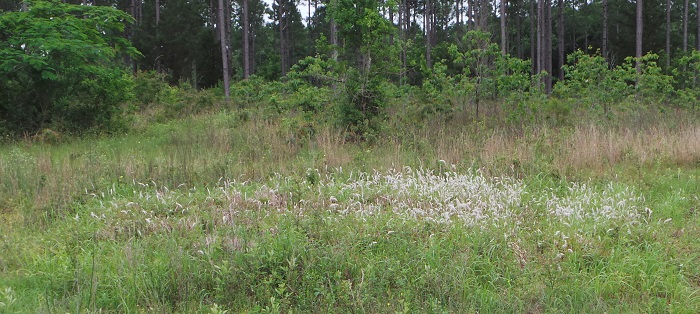
A relatively new patch of cogongrass recently found in Washington County.
Photo Credit: Mark Mauldin
More information on cogongrass can be found by following the links below
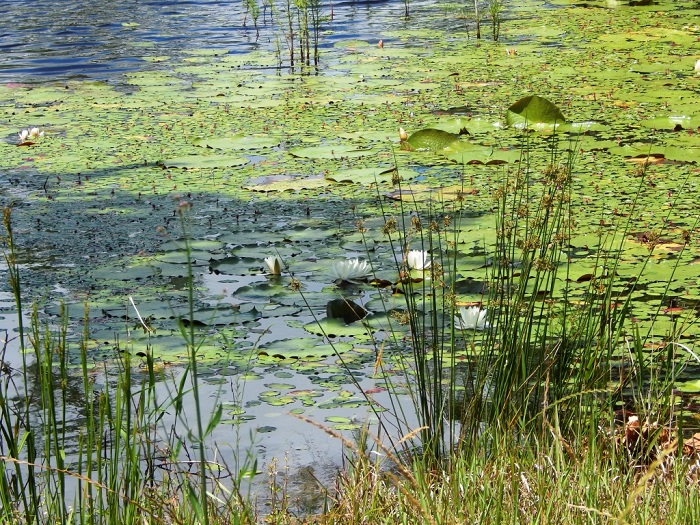
by Mark Mauldin | Apr 17, 2015

Monitor your ponds closely throughout the spring and make any necessary herbicide applications before weed growth becomes too excessive.
Photo Credit: Mark Mauldin
Similar to Goldilocks’ porridge, water temperature doesn’t need to be too hot or too cold, it needs to be just right for using aquatic herbicides (70o – 80o F). Here in Florida, these optimum water temperatures occur in the spring. Water temperature largely regulates the growth of most aquatic weeds; cool temperatures slow or stop growth and warm temperatures promote growth. Keeping this simple principle in mind can help determine when to use aquatic herbicides.
Generally speaking, aquatic herbicides are not used when water temperatures are below 60o F. When water temperatures are this cool most aquatic weeds are not actively growing. For herbicides to be effective the target plants must be actively growing. Applying herbicides too early in the spring is generally not an issue because winter dieback can make many aquatic weeds hard to find when water temperatures are cool. The weeds are out of sight and out of mind. The much more common issue is waiting too long before attempting to control weeds.
As water temperatures climb above 60o weeds begin to grow. Unfortunately, they often times grow unnoticed throughout the spring until they become completely out of control in the summer. By this point, control, even using herbicides, is a monumental task. If at all possible, control weeds early in the growing season.
As plants grow they are able to build up energy reserves, making them more difficult to control. The longer they are allowed to grow the stronger and more difficult to control they become. Controlling weeds earlier in the growing season eliminates this problem.
Similarly, as the growing season progresses plants produce more and more biomass. If an herbicide is applied and the weeds are killed large amounts of decomposing plant material in the water can cause problems. The decomposition process uses oxygen; dissolved oxygen can drop to levels that are hazardous to fish and other aquatic species. The more plant material that is present when herbicides are applied the bigger concern this becomes. Applying herbicides earlier in the growing season, before large amounts of biomass are produced, can help lessen this problem.
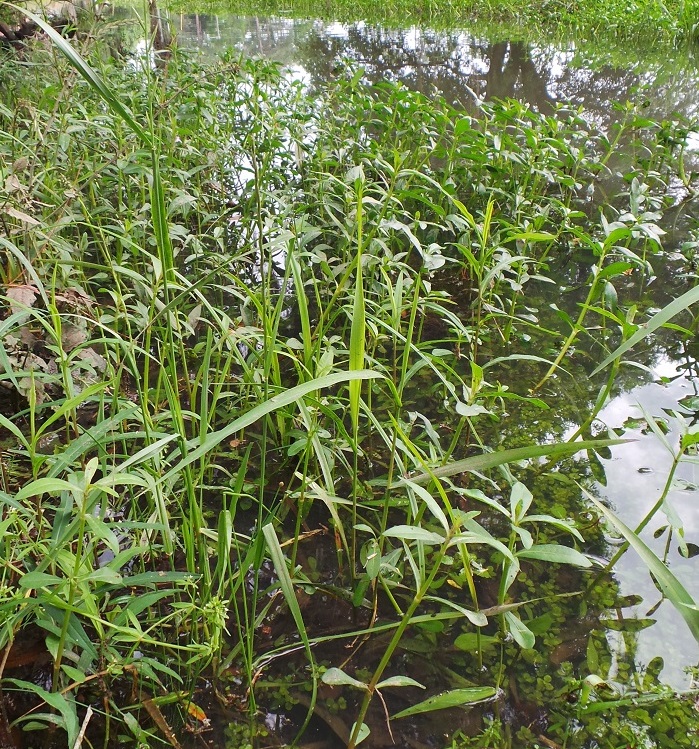
Aquatic weeds can grow rapidly when temperatures are warm. Don’t let them get out of control before you begin control efforts.
Photo Credit: Mark Mauldin
Further compounding the issue, warm water is physically able to hold less dissolved oxygen than cooler water. Late in the summer pond water can be very warm with low concentrations of dissolved oxygen even before large amounts of decomposing plant material are added.
To help reduce the risk of oxygen depletion never treat more than ½ of a pond at one time, if weed growth is already substantial treat no more than 1/3 of a pond at one time and always allow 10 -14 days for oxygen recovery between treatments. Also, avoid treating on cloudy days, another factor that can lead to lowered dissolved oxygen.
Aquatic weed control will be easier and more effective if you monitor your pond throughout the spring and make any needed herbicide applications early, before the weeds have grown too large and the water is too warm. Consult your county extension agent for assistance determining what aquatic weeds you have and if treatment is necessary. Always read and follow all label directions when using any herbicide.













